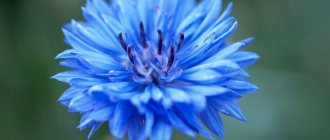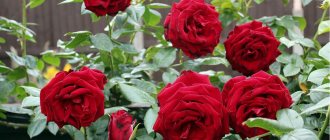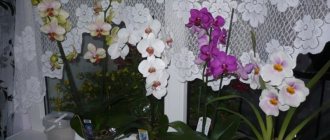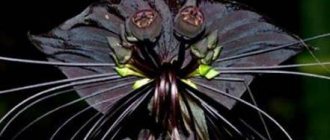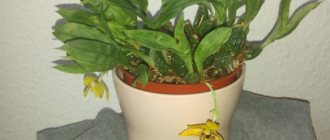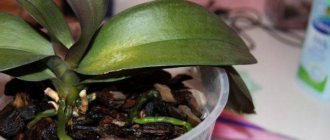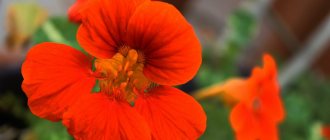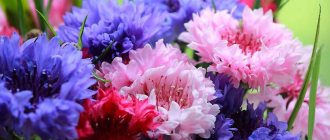The orchid has long become a familiar resident of our apartments and houses. They give it as a gift for holidays, collect it, and don’t think about what it looks like in the wild.
It is important for owners of each domesticated species of orchids to know what the conditions of their natural growth are.
Knowing in which country representatives of a particular species grow, the florist will better understand what an exotic beauty needs.
Orchids in nature: how and where do they grow?
The orchid is a very common plant and can be found around the world in 35,000 varieties. They can be found on all continents in tropical and temperate latitudes.
The largest number of species of these beautiful plants grow in the tropics. These conditions are most suitable for orchids.
Orchids need warmth and humidity. With their special root system, wintering in cold regions is impossible, so in apartment conditions it is important to prevent frosty air flow.
Saprophytes
This species is unusual in its appearance. Saprophytes are not like the phalaenopsis we are used to. These orchids do not have leaves, grow on the ground and have deep, thick roots. Outwardly, they look like corals and do not create thin processes.
They form a symbiosis with mycelium , feeding on substances and water from humus and peat. The orchid has a thin stem covered with scales. The flowers are small and inconspicuous.
Saprophyte Common nester (photo in natural conditions).
The absence of leaves and chlorophyll allows the plant to live in shady places under the canopy of trees.
Epiphytes
Orchids of this group are the most familiar and familiar to all gardeners. Common species such as phalaenopsis and vanda are epiphytes.
Epiphytes do not grow on the ground. Their roots contain velamen, which absorbs water like a sponge. In an effort to hide from herbivores and excess water, the orchid climbs onto vertical supports. It can grow on a tree or stone.
Many people incorrectly believe that epiphytes are parasitic. Being on a tree, the orchid does not harm it and does not damage the bark. Receives water from the environment. Warm tropical rain, morning dew and fog satisfy the plant's fluid needs. Thick leaves and roots are able to retain moisture for a long time, so epiphytes are not afraid of unexpected drought.
The abundance of colors and shapes makes the flowers of these orchids attractive to insects, and the climate conditions are ideal for propagation by seeds. Under natural conditions, orchids easily form seed pods , their flowers are large, and their leaves reach a length of thirty centimeters.
Epiphyte Vanda (photo in the wild).
Epiphytes bloom all year round , forming long inflorescences. Seeds remain viable for up to 2 years, because even in ideal conditions it is difficult to find a suitable place for a sprout.
Interesting! Epiphytes do not need soil or peat. They have adapted to live in trees, using them as support.
Ground
Such plants have green shoots and roots buried in the ground. Just like epiphthites, their roots have velamen and no small shoots. Such a root system needs light soil with a high air content.
Terrestrial orchids prefer the top layer of light forest soil. It consists of moss, bark and peat. Water does not stay here for long, so this composition is ideal for terrestrial species.
The height of these plants in natural conditions can be above 60 cm. As the root system grows, it produces new shoots, so the orchid looks like a huge bush with many flowers. Each trunk blooms only once in its life and devotes all its strength to the formation of seeds and the growth of new shoots.
Terrestrial orchid Cymbidium (photo in its natural environment).
Orchids of this species are able to accumulate water in thickened shoots or pseudobulbs. In unfavorable periods, some of them shed their leaves and lose part of the root system.
Prominent representatives of terrestrial orchids include:
- Cymbidium;
- Miltonia.
Frequently occurring species
Royal
The royal orchid is a large-flowered variety of phalaenopsis . It is distinguished by its large flower size (from 10 cm), long peduncles and wide leaves.
In the natural environment, phalaenopsis of this size is difficult to find, since this is the result of selection. However, it can be found in the tropical forests of India, Indonesia and China, provided many factors coincide.
The epiphyte is demanding of bright light and nutrients. If one of the conditions is lacking, the plant produces smaller flowers.
The peduncle of the royal orchid reaches a height of 1.5 m and can branch. Smelling representatives are often found.
Flowering lasts up to 7-8 months. It takes a lot of energy for the plant to maintain large flowers, so a second peduncle appears extremely rarely.
Lyubka bifolia
The plant is often found in temperate forests and has a second name - night violet. It has an unsightly appearance, small white flowers and a delicate aroma that attracts insects.
This is one of the wintering orchids. It survives frosts due to the presence of a tuber, which is a thickening of the root for the accumulation of nutrients. It forms a symbiosis with the mycelium and is renewed every year by dying and growing a new one. Young tubers can be collected for medicinal purposes.
Lyubka bifolia.
Flowering period: May, June. It forms seed pods in August; the leaves and peduncle die off in the fall.
Reproduction occurs only with the help of seeds, so collecting the flowers of Lubka bifolia leads to the extinction of the species.
Attention! Lyubka bifolia is an endangered species and is prohibited for collection in the forests of Russia.
Lady's slipper
The plant got its name due to the unusual shape of the petal. The lower part of the stigma was formed as a result of the fusion of two petals, which formed a “shoe”. There is a legend about the goddess Venus, who lost her shoe while walking in the forest.
Natural habitat is temperate forests . The plant is capricious and is on the verge of extinction due to collection. Listed in the Red Book.
It is rarely possible to see a lady's slipper in its natural form. It can be found in nature reserves, botanical gardens and places where people rarely go.
The plant is shade-loving and requires moisture . Grows only in light soil with neutral pH and high lime content.
Reproduction is vegetative and seed , which facilitates the spread of the species.
Interesting Facts:
- Long-lived. Lives up to 100 years or more;
- For seed germination, mycelium is necessary;
- Prefers to be adjacent to both pine and birch trees;
- Flowers are formed only in mature plants that are more than ten years old;
- Is on the verge of extinction;
- It has a second name - Russian orchid.
The lady's slipper is protected in all European countries.
The lady's slipper has different colors . Its flowers can be yellow-burgundy, pink, white and green with various spots and wavy shape of the petals, exuding a pleasant aroma.
Orchis spotted
The medicinal plant spotted orchis is familiar to many gardeners as “cuckoo tears.” Unlike most orchids, it prefers clayey, swampy soils . The plant is distributed throughout Russia, excluding the Far North region.
The root system forms a tuber that accumulates nutrients and easily survives the cold. With the arrival of spring, the bulb devotes all its energy to growing flowers, leaves and a new nodule.
The orchis tuber is collected for medicinal purposes , as its pulp contains a large amount of useful substances. The bulb is edible and its nutritional value can last for the whole day.
Good to know! Spotted orchis survives transplantation well and is easily “cultivated.”
It blooms in early summer with small lilac flowers . By August, ripe seeds are formed, however, in order to germinate, they need symbiosis with the mycelium. In addition to seeds, it reproduces vegetatively.
goodyer repens
Found in coniferous forests of the Moscow region . Its peculiarity is a creeping rhizome, with the help of which it reproduces.
A special feature of this orchid is its ability to go underground . When there is not enough light for the growth of green shoots, it turns into a saprophyte, forming a symbiosis with bacteria and fungi.
After improving the lighting, it produces greenery and blooms. If conditions have not changed, then it dies.
Nest
Common nesting plant is an unusual plant. His appearance does not remind her of her beautiful relatives. The plant has no green leaves and is a saprophyte . Its main color is brown.
The roots form a tight bunch, reminiscent of a bird's nest. Because of this feature, the nesting site got its name. From the roots come yellowish-brown shoots with a cluster of flowers emitting a sweet aroma.
Interesting! The common nester reproduces only with the help of seeds, of which more than 10,000 are produced per flowering.
Classification of wild orchids
Orchids in the wild can behave completely differently. The appearance, method and area of growth largely depend on the variety in question. The flower is located in such a way that it is possible to receive moisture, sunlight, and nutritional components.
Saprophytes
This type of orchid grows underground. There are no leaf blades, only a white root system. They survive well without sunlight and can parasitize other plants. The bud inflorescence is quite complex, the aroma is pleasant.
Epiphytes
The difference between these types of plants is the presence of aerial roots. As you know, roots take part in photosynthesis. Exposed roots cling to the bark and can be found on rocks.
Terrestrial species
Phalaenopsis growing in nature has a traditional root system. As a rule, these species are found mainly in temperate climatic conditions. In appearance they resemble ordinary wildflowers, growing vertically.
Features of the growth of orchids in nature
In total there are more than 70 species of phalaenopsis. Many of them are epiphytes, meaning they do not require rooting. Orchids grow in nature on other plants or stones, which are used as a support or a kind of stand. The culture takes the necessary substances from tree bark, moss, and fallen leaves.
On the trees
Under natural conditions, phalaenopsis requires support, which can ensure normal growth. It is for this reason that they can be found quite often on trees. Bark and branches are the best option for support for a number of reasons - the crown protects from the sun, good adhesion to the bark, and an abundance of microorganisms.
On the rocks
Orchids in nature can be found growing on stones, rocks or cobblestones. The root system is quite delicate, so it cannot tolerate excess and stagnation of moisture. Reproduction is carried out using rhizomes and seeds.
On the ground
Some varieties of plants grow in forests on a peat bed. During growth, a symbiosis is formed with mycelium, from which orchids receive all the nutritional components necessary for growth. Reproduction is primarily by seeds, but sometimes tubers and layering may be involved in this process.
Commonly found species in the wild
There are a large number of flowers found in nature; the color palette of orchids is rich and varied. Plants differ from each other not only in the structure of the root system, the shade of the buds, but in the place of growth.
Royal
The royal type of orchids in the wild is distinguished by the largest flowers. The size can reach up to 10 cm, the leaf plates are quite wide. This variety is extremely rare, as it was bred by breeders. However, royal orchids can be seen in Indian forests.
Lyubka bifolia
This flower can often be seen in latitudes with moderate climatic conditions. Lyubka bifolia has a second name - night violet. The appearance is unsightly, the inflorescences are small and white, but there is a bright, rich aroma that attracts insects.
Lady's slipper
This name was received due to the interesting shape of the petals. As a result of the fact that several petals have grown together, they resemble a small shoe. There is a legend that says that once the goddess Venus was walking through the forest and during her walk she lost her shoe.
Orchis spotted
It is a medicinal crop. It grows mainly on clay and marshy soils. It can be found in forests throughout Russia, with the exception of the Far North. During flowering, lilac-colored buds appear.
goodyer repens
This type of orchid can be seen in coniferous forests in Moscow and the Moscow region. A distinctive feature is the creeping root system, with the help of which the reproduction process occurs.
Nest
The nesting bird is a rather unusual species. The flowers do not have leaf plates, the main shade is brown. The roots grow together into a bunch, reminiscent of a bird's nest, which is what influenced the name.
Cattleya
In nature, the culture can be found on trees and stones. The life cycle, as a rule, consists of several phases - flowering period, dormancy, active growth. The buds are quite large, differ in shades, and are velvety. If necessary, you can see a photo of how a wild orchid grows.
Phalaenopsis
It has another name that is used by many gardeners - orchid for a beginner. The plant grows on trees and receives moisture from the environment. Roots participate in photosynthesis. The buds resemble butterflies in appearance.
Tropical
As practice shows, many types of wild orchids have been made domestic. Now every gardener can admire the beauty of South American beauties, if favorable conditions are created for this. Tropical varieties include phalaenopsis, cattleya, vanda and many others.
Why is it called a “miracle of nature”
In South America, orchids are called a miracle of nature, due to their unusual and attractive appearance. In addition, some species growing on trees hang down, forming clusters, which is a rather rare occurrence.
Adaptation to the environment
Orchids grow almost all over the globe, with the exception of the poles. Therefore, they can be found in these places:
- On the trees. Orchids with an epiphytic lifestyle grow on the tree table. They attach themselves to the surface of the plant with their roots, so they prefer species with rough bark. Moisture and humus collect well in its cracks. Reproduce by seeds and layering;
Orchids can grow on trees (photo of phalaenopsis).
- On the rocks. Lithophytic orchids are found on rocks and cobblestones. Their roots are very delicate and do not tolerate stagnant water. They reproduce by rhizomes and seeds;
- On the ground. Some types of orchids grow on the peat substrate of the forest. They form a symbiosis with the mycelium, receiving nutrients from it. They reproduce by seeds, sometimes by tubers and layering.
Classification of orchids
Tropical
Flower growers were able to “domesticate” some orchids and establish rules for their cultivation. Flowers found in stores:
- Dendrobium;
- Phalaenopsis;
- Cattleya;
- Cymbidium;
- Miltonia;
- Wanda;
- Oncidium;
- Cumbria.
Let's look at some of them in their natural habitat.
Dendrobium
As the name suggests, the orchid likes to use trees for support . There are more than a thousand species of dendrobium. They vary in flower shape and size, stem height and behavior throughout the year. Many species shed their leaves and have a dormant period.
Dendrobium kingianum.
Cattleya
In its natural environment, cattleya grows on trees and rocks. The life cycle has three phases: flowering, dormancy, active growth. The flowers are large, of different colors, and have a velvet covering. Look below at the photo of how orchids grow in the wild.
Cattleya.
Phalaenopsis
It is also called the beginner's orchid. This tropical beauty grows in nature on trees, absorbing water from the environment. The roots of the plant are involved in photosynthesis and moisture accumulation. Phalaenopsis flowers, similar to a butterfly, attract with their beauty and size.
Phalaenopsis in nature.
The most unusual
The unusualness of these orchids is due to the shape of their flower. They amaze the average person with their appearance. Many gardeners would like to have them in their collection. Next you can see photos of orchids growing in the wild and read their description.
Peristeria tall (dove orchid)
The orchid has snow-white flowers whose central petals resemble the shape of a dove.
The orchid blooms very rarely (after reaching 10 years of age) and has from 2 to 5 buds.
The stem forms a large pseudobulb that accumulates water. The orchid leaves reach one meter, and the flowers are 6 cm.
Interesting! The birthplace of Peristeria alba is Panama. There she is revered as a national symbol and a symbol of peace.
Caladenia melamena (ballerina orchid)
The unusually shaped flowers of this plant resemble a ballerina in a white tutu and with her arms raised. The orchid is very rare and grows only in Australia.
Caladenia melamena.
Kaleana (duck orchid)
The miniature flowers of this plant are only 2 cm long . Kaleana is a terrestrial orchid. Prefers to grow in tall grass in Australia. Loves proximity to eucalyptus.
The shape of the flower is similar to the delicate shape of a duck with delicate thin wings and a well-defined head. The flowering period lasts from September to January.
Kaleana.
Anguloa uniflora (babies in diapers)
The orchid grows in the high mountain forests of South America. During a certain flowering period, the pink and white petals fold into a shape similar to a swaddled baby. At this moment the flower has a bright sweet aroma.
Anguloa single-flowered.
Habenaria radiata (heron orchid)
This orchid is called the oriental beauty. Its habitat is the marshy areas of Japan, China and Korea.
The snow-white petals of the orchid are shaped like a heron that has spread its wings. During the dormant phase it sheds its leaves.
It is very popular in Japan and successfully bred at home.
Habenaria radiata.
Dracula Orchid
The second name of this plant is monkey orchid. The central part of the burgundy flower has a contrasting white color. It is shaped like a monkey's face. Grows in South and Central America.
The epiphyte has more than a hundred species. They have different flower appearance. Color varies from white to dark brown.
Dracula Orchid.
Risantella gardner (subterranean orchid)
One of the most amazing orchids. If you meet it in its natural environment in Australia, you would not think that this plant is an orchid. Forms a symbiosis with shrubs from the myrtle family through the mycelium of the fungus Thanatephorus gardneri.
Has no leaves. A white and pink inflorescence with many burgundy flowers rises above the ground. Has a sweet aroma.
Risantella Gardner.
Growing in temperate latitudes
Despite the huge abundance of tropical beauties, orchids are also found in temperate latitudes.
Pollenhead
The plant is found in dry shady forests of mountainous regions. To obtain nutrients, it forms a symbiosis with mushrooms. Propagated by root shoots and seeds. There are small-flowered and large-flowered species.
Pollenhead.
Interesting! Flowers have no nectar.
Kokushnik
Small flowers appear only after 5 years of life and have a subtle vanilla aroma.
The root system looks like a system of tubers that interact with the mycelium.
Kokushnik.
Dremlik
Dremlik marsh prefers marshy areas . Forms inflorescences with small beautiful flowers. It blooms in mid-summer and attracts insects with its intoxicating smell.
It is a light-loving plant, so it can only be found in open areas.
Dremlik swamp.
Calypso bulbous
A delicate orchid that loves solitude, grows in cool, damp areas . Prefers open forests.
It blooms in early spring and easily withstands late frosts. It produces a single leaf, which dies after flowering.
Calypso bulbous.
Anacamptis pyramidalis
The plant belongs to the orchis species . It has wintering tubers and a long stem reaching a height of up to half a meter.
It reproduces by seeds, of which a lot is produced. They are similar in size to dust particles and are spread by the wind.
Anacamptis pyramidalis.
Comperia compera
It has unusually shaped flowers. Tendrils extending from the petals hang down. Because of its appearance, the orchid is loved by flower growers and florists.
Distributed in Crimea.
Comperia compera.
Traunsteiner spherical
Grows on the damp mountain slopes of the Caucasus and Crimea . It is also found in other regions of Russia and Ukraine.
Traunsteinera is spherical.
Unusual orchids in nature
Among orchids, there are plants that can not only charm with their attractiveness, but also surprise, and sometimes simply stun, with their slightly unusual appearance. Their flowers can resemble anyone, but not the traditional petals with pistils familiar to us all. Where do such orchids grow in nature?
The most famous of them:
Peristeria elata - dove orchid or "holy spirit" orchid, the national symbol of the state of Panama. Its flower really resembles a dove with raised wings. It lives naturally in Central America and slightly covers the northern coast of South America with its habitat. They say that if a dove orchid blooms, it means peace and prosperity will come to the house.
Peristeria elata
Caladenia melanoma - better known as Ballerina Orchid. A striking representative of the flora of Australia suffers from animals grazing in the meadows and gradually reduces its population, becoming a very rare orchid.
Caladenia melanoma
Kaleana (Caleana major) - a duck orchid in English-language sources is called Flying Duck Orchid. It is difficult to see in the grass until it blooms. The petals of its corolla are folded in such a way that it looks as if there really is a silhouette of a bird with a characteristic duck beak before your eyes. The flower can only be found in nature in the state of Queensland on the Australian continent.
Caleana major
Anguloa Uniflora - the plant has the popular name Swaddled Babies, translated - “babies in swaddling clothes”. This exclusively South American orchid has very touching flowers - as if a tiny child fell asleep under a canopy of petals bent towards him.
Anguloa Uniflora
Habenaria Radiata is a rare flower native to Japan. It is also called White Egret Orchid, translated as “white egret orchid”. It really does look a lot like a bird with snow-white wings soaring in the sky. It is a very capricious plant in cultivation and is not recommended for beginners. The Hisyo variety is known, which is more adapted to home conditions than the natural variety.
Habenaria Radiata
Habenaria Grandifloriformis - among flower growers is called the angel orchid, because its flower looks like a man in a hood with outstretched wings. In nature, it lives in the southern regions of India.
Habenaria grandifloriformis
Monkey orchid (Dracula simia) - in the English interpretation of Monkey Face Orchid. The flowers of the plant are very similar to the face of a monkey, and the spurs are exactly like the fangs of the famous bloodsucker. This sweetest creature of nature smells like a ripe orange, and in nature lives in the mountains of Colombia, Ecuador and Peru.
Dracula simia
Ophrys apifera - many representatives of the genus Ophrys have flowers that from a distance look like some kind of grimacing faces. This species actually resembles a bumblebee, but the coloring of the petals at the base and lips forms a charming smiling mouth. So we got the “laughing bumblebee” orchid.
Оphrys apifera
Ophrys bombyliflora - the brown pubescent flower of the plant from a distance looks like an exotic spider, legs tucked up and sitting on top of a rosette of leaves on a blade of grass-peduncle. Without a doubt, the spider orchid deservedly received its popular name.
Ophrys bombyliflora
Italian orchis (Orchis italica) - in English-speaking countries this plant is called “naked man orchid”, translated as “naked man orchid”. There are many interesting species in the Orchid genus that have adapted to the temperate climate of Eurasia and North America; many live in the mountains of the Caucasus and Crimea.
Orchis italica
Rhizanthella gardneri is an underground orchid native to Australia. If it weren’t for the aroma, people would have remained ignorant for a long time that such a unique plant exists in nature.
Rhizanthella gardneri

